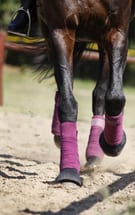Equine Lameness
 Lameness, an abnormality in a horse's gait or stance, is a common and troubling symptom in horses. It can be caused by a great many factors and may present with a variety of symptoms. Although lameness in horses can be serious, its is frequently quite curable. While historically horses faced a grim prognosis for many kinds of lameness, at present the percentage of horses that have to be euthanized as a result of lameness is down to approximately 2.5 percent.
Lameness, an abnormality in a horse's gait or stance, is a common and troubling symptom in horses. It can be caused by a great many factors and may present with a variety of symptoms. Although lameness in horses can be serious, its is frequently quite curable. While historically horses faced a grim prognosis for many kinds of lameness, at present the percentage of horses that have to be euthanized as a result of lameness is down to approximately 2.5 percent.
Causes of Equine Lameness
Causes of equine lameness can be put into the following general categories:
- Degenerative disease (arthritis)
- Infection such as abscess or cellulitis
- Traumatic or overload injury
- Inflammatory disease
- Orthopedic disease or tumor
- Metabolic or neurological disorder
- Laminitis
- Tacking problem
As with most medical problems, equine lameness can, in some cases, be described as idiopathic, meaning its origin is unknown.
Symptoms of Equine Lameness
In addition to the most obvious symptom of limping, a horse that is lame may show one or more of the following:
- Shifting weight from one side to the other
- Holding one foot up
- Having difficulty turning
- Dragging a foot
- Slower than normal gait
- Incomplete lifting of hooves, toe dragging
- Head bobbing
Behavioral or loss-of-function symptoms, like those listed above, may be accompanied by physical signs of difficulty, such as obvious pain, swelling, heat or redness in the affected area.
Diagnosis of Equine Lameness
 There are several means available to diagnose equine lameness. Some can be used by the horse's handler, but some must be be administered by the veterinarian.
There are several means available to diagnose equine lameness. Some can be used by the horse's handler, but some must be be administered by the veterinarian.
Medical History
In attempting to diagnose equine lameness, it is important to consider the horse's age, regular routine, general health, medications and vaccinations, exposure to illness and any recent accidents, even minor ones. It is also important to note when the lameness began and whether it is improving or worsening.
Observation
Careful observation of the hoof, the shoe, the placement of saddle and reins may help to detect the problem. Discoloration, discharge or odor from the hoof or leg may also be clues. In addition, evaluation of the horse's stance and gait are invaluable tools in diagnosing the reason for lameness.
Palpation
Through palpation, the examiner can feel for pain, swellings, depressions or other abnormalities, or detect any anomaly in the horse's pulse at the site.
Manipulation
Manipulation can help to indicate how the horse reacts when its leg is moved, its back examined, or its hoof squeezed or tapped with the hoof tester. Sudden withdrawal or grunting may indicate pain.
Diagnostic Tests
Depending upon the finding of a physical examination, diagnostic imaging tests may be necessary. These may include X-rays, thermal imaging, ultrasounds, MRI or CT scans.
Treatment of Equine Lameness
The simplest treatment for any horse showing evidence of lameness is to keep the animal at rest. Applying a pressure wrap around the affected leg can also be helpful, but unless there is rapid improvement, the horse must be seen by a veterinarian. The first veterinary treatment is usually the administration of analgesics and anti-inflammatory injections.
Whether or not surgery is required, most horses with lameness require some rehabilitation. Depending on the severity of the condition, the horse can be treated at home or sent to a rehabilitation center.
In some cases, alternative therapies may be effective. These include extracorporeal shock wave therapy (ESWT), bone marrow transplants, stem cell therapy and treatment with interleukin-1 receptor antagonist protein (IRAP).
